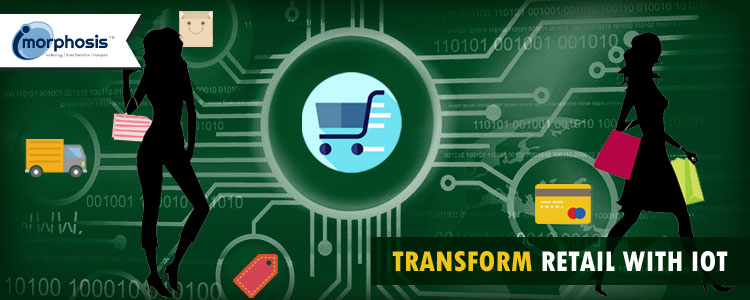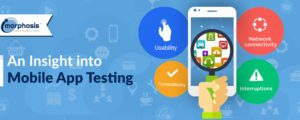Internet of Things (IoT) is an emerging ecosystem that connects devices, people, data, products, and services. The combination of forces- Smart devices in the form of wireless networks and sensors, Big Data and Fast connectivity are the driving forces of this emerging technology. The wave of IoT is disrupting the traditional way of business, creating unprecedented opportunities and the retail sector is riding on the crest of this wave to bring about business transformation.
IoT lies to the core of transformation in retail sector. For brand equity and improved sales, customer engagement is the key, and this sophisticated technology aims at touching the lives of customers across different inter-sectional points of the varied sales channel. The IoT will strengthen the customer experience, boost the productivity, reduce cost by effective utilization of assets, lower time to market and increase the return on R&D investments.
Already the retailers are investing in IoT to improve customer experience, streamline the information flow and processes, add value to the customers and explore the new avenues of revenue growth. As per Juniper Research report published in mid-2015, retailers are willing to spend almost $2.5 billion for installation of IoT hardware by 2020, which is four times more than the amount spend in 2015.
A report of MarketsandMarkets estimates that the market size of IoT in retail will grow from $14.28 billion in 2015 to $35.64 billion in 2020 at a CAGR OF 20.07 percent.
The IoT leverage for Retail
Retail business is now transforming their practices as IoT touches almost every segment of customer engagement and retail operations. The technology will help entrepreneurs to rediscover their potential, and adapt new technologies and changing business ecosystem. This transformational opportunity aims at
Connected Customers– The ubiquitous connectivity lets the customers have access of unlimited data and information through different channels- online and offline. The customers are well-informed and the speed and agility of purchase process now influence their demands and shopping behavior.
Smart Retailers– IoT provides retailers the access to customers at a global level and helps them to collect information of present and potential customers. By adopting this new technology retailers can now utilize the information, capitalize it and stay ahead of the others.
The four major IoT applications for smarter processes in retail industry and heightened shopping experience are:
- Use video feeds and in-store sensors to understand and analyze customer flow patterns, hot spot and placement of promotional offers to deliver better shopping experience.
- Sensors to keep a track of the inventory and re-route the delivery vans based on traffic updates and weather forecasts.
- Use CCTV recording and improved Video Analytics to refill the shelves. This in a way boosts conversion rates and provides better customer experience.
- Sensors to automate energy savings and reduce the carbon footprint.
Transformation in the Retail industry
The focus of IoT is to create better customer experience, create new opportunities and improve revenue stream. Data generated by connected devices help in reshaping the shopping experience of customers and increase the market share. Internet of Things will enable retail businesses to explore new markets in the digital ecosystem. IoT can bring about business transformation in retail industry by below mentioned ways
Improve customer experience– Customer experience lies central to the success of the Retail industry. IoT assures an improved and personalized customer experience that is meaningful to them. It helps retailers to create an ecosystem that connects both digital and physical worlds, and generate data on consumption behavior of prospective customers. Retailers will now get single view of customers, their purchase patterns and provide a relevant shopping experience. On the real-time insights, retailers can shape the brand experience that are in tandem with customer interests.
Optimize the in-store operation – Data collected by different sensors help retailers to manage store employees and assets effectively. IoT-enabled devices like beacons, CCTV cameras and sensors in the stores, along with the apps of smartphone will generate real-time data that highlights purchase behavior and traffic pattern in the store. For instance, track the movement of customers with the use of beacons and implement it in improving strategies involving goods placement and store layout.
Effective promotion – With the use of analytics, retailers can predict possible purchase pattern of the customers. It will be easy for retailers to understand what makes a customer to pick a product- their mindset and why particular products are sold at a specific time of the day. Based on the requirement and location of the customer, businesses can craft their marketing campaign and promote products. The digital tags used in the IoT-enabled ecosystem let products adjust the price as per the demand. Again the IoT-enabled trollies help customers to navigate the store depending on their shopping list.
Better supply chain and inventory management – Retailers can leverage big data, cloud technology and devices to connect the digital and offline worlds. IoT-enabled devices aid retailers to track the inventory seamlessly. These devices can analyze the performance of products, stocks, impact of a particular time slot, weather conditions, recent trends and other variables. RFID and geotags help the IoT-enabled devices let the retailers know the location of products and wear and tear that it undergoes during delivery. The devices will integrate the centralized information system with in-house logistics, products, warehouse and suppliers. These sophisticated devices make inventory, warehouse, logistics and supply chain management cost-effective. Timely coordination improves performance and reduces the cost of operations.
Explore new channels of earning revenue – Retailers can seek out new avenues of earning revenue and expanding their operations. In-store app is an effective method of reducing the wait times of the customers. For instance, customers can get notification and alerts about the wait time in different segments of the store in advance. Another effective method is to connect the home with retail stores, which helps items to be replenished fast and conveniently. Sensors on different home appliances ensure automatic order placement when required.
IoT will enable retailers to create relevant and real connection that will empower the customers. Retailers who adopt to this technology will get an advantage in this competitive environment.
Source : ThoughtWave
Approach for a successful Business Transformation with IoT
Internet of Things is a string that connects customers, appliances, sensors, mobile, location, goods with the internet. It gathers data at an unprecedented rate and allows seamless information flow across different channels.
So the question is, how businesses will ensure a successful transformation with IoT. To harness the benefits of this advanced technology and get the desired result, a smart retailer would not be restricted only to embracing the new technology, rather invest strategically invest in it. The best way to bring out the best is to connect infrastructure of the company with technology. Core areas that the retailers need to focus are
- Retail Infrastructure – For a successful IoT-enabled system, retailers need to ensure that appropriate governance, talent and exists in the organization. Customer needs should be the main focus. Implementing agile development techniques help in improving the deployment time of IoT.
Confirm that IoT based solutions are at par with the business strategy. IT experts and business strategy should forge a strong partnership to develop a long-term and short-term strategy. For this, evaluate the existing channels, products, and assess the existing policies and infrastructure of the company against the goal. Identify the areas through which you can improve the revenue.
A cross-disciplinary approach is important- retailers need to align IT with operations, supply chain management and other stakeholders to design and implement the IoT-enabled solutions. Since different technologies, data, connected devices, connectivity and telematics are involved, choosing the perfect partner will determine the success.
- Technology – Technical capability is another important factor that determines success. To garner the wealth of customer related data, IT experts need to concentrate on big data/analytics, customer-centric applications and in-store infrastructure. It is essential for security policies and connectivity to support the IoT functionalities.
Big data– Retailers need to formulate a strategy to store, secure and use data at an enterprise level. Advanced analytics will help entrepreneurs to understand the customer behavior, predict their future purchases and provide better services based on it. Collaborating the data from different sources will provide valuable insight to retailers about customer preferences and trends. Real-time analytics helps in connecting the customers and engage them.
Infrastructure– Beacons, RFID, sensors form an integral part of IoT ecosystem. These devices identify registered customers and send them notifications based on the purchase history. The network security plays an important role for a smooth information flow and operations.
- Privacy and Security – When planning business transformation with IoT, data security and privacy is really important. Consider the factors like technology, processes and people that causes security breach and its impact on customer relationship. The security practices need to be sound and robust so that customer experience is not hampered.
The retailers need to have a well-documented Privacy Policy that explains how they collect customer information and steps to prevent sharing data with the third party companies. To encourage data sharing, retailers can introduce options like loyalty rewards, exclusive rewards and incentives.
Harmonize the factors– The success of business transformation lies in connecting the three above-mentioned factors. Retailers need to use advanced technology to capture relevant data. Their infrastructure, Data security policies play an important role to reap maximum benefit.
Retailers need to invest in Internet of Things to bring about a transformation their retail business. Early birds can reap benefits like increase in revenue by providing better shopping experience and brand to customers. A sound strategy that amalgamates the three factors help the retailers to position them high in the growth wave. So, retailers formulate a strategy fast and implement processes that matches the business transformation goal.





Pingback: Enterprise Mobility will Explore New Opportunities in Future()
Pingback: 9 Emerging Digital Transformation Trends of 2017 - Enterprise IT Services, Business Transformation, Outsourcing()